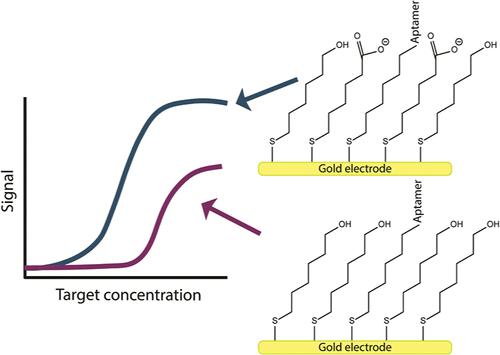Carboxylate-Terminated Electrode Surfaces Improve the Performance of Electrochemical Aptamer-Based Sensors
IF 8.2
2区 材料科学
Q1 MATERIALS SCIENCE, MULTIDISCIPLINARY
引用次数: 0
Abstract
Electrochemical aptamer-based (EAB) sensors are a molecular measurement platform that enables the continuous, real-time measurement of a wide range of drugs and biomarkers in situ in the living body. EAB sensors are fabricated by depositing a thiol-modified, target-binding aptamer on the surface of a gold electrode, followed by backfilling with an alkanethiol to form a self-assembled monolayer. And while the majority of previously described EAB sensors have employed hydroxyl-terminated monolayers, a handful of studies have shown that altering the monolayer headgroup can strongly affect sensor performance. Here, using 4 different EAB sensors, we show that the mixed monolayers composed of mixtures of 6-carbon hydroxyl-terminated thiols and varying amounts of either 6- or 8-carbon, carboxylate-terminated thiols lead to improved EAB sensor performance. Specifically, the use of such mixed monolayers enhances the signal gain (the relative change in the signal seen upon target addition) for all tested sensors, often by several fold, both in buffer and whole blood at room temperature or physiological temperatures. Moreover, these improvements in gain are achieved without significant changes in the aptamer affinity or the stability of the resulting sensors. In addition to proving a ready means of improving EAB sensor performance, these results suggest that exploration of the chemistry of the electrode surface employed in such sensors could prove to be a fruitful means of advancing this unique in vivo sensing technology.

羧酸端接电极表面改善了电化学适体传感器的性能
基于电化学适配体(EAB)的传感器是一种分子测量平台,可以在活体中连续、实时地测量各种药物和生物标志物。EAB传感器是通过在金电极表面沉积硫醇修饰的目标结合适配体,然后用烷硫醇回填形成自组装的单层来制造的。虽然之前描述的大多数EAB传感器都采用了端羟基单分子层,但少数研究表明,改变单分子层头组会强烈影响传感器的性能。通过使用4种不同的EAB传感器,我们发现由端羟基6碳硫醇和不同数量的端羧酸6碳或8碳硫醇组成的混合单层可以改善EAB传感器的性能。具体来说,在室温或生理温度下的缓冲液和全血中,这种混合单层膜的使用提高了所有测试传感器的信号增益(目标添加时信号的相对变化),通常提高了几倍。此外,这些增益的改善是在没有显着改变适体亲和性或由此产生的传感器的稳定性的情况下实现的。除了证明了一种改善EAB传感器性能的现成方法外,这些结果表明,对这种传感器中使用的电极表面化学的探索可以证明是推进这种独特的体内传感技术的富有成效的手段。
本文章由计算机程序翻译,如有差异,请以英文原文为准。
求助全文
约1分钟内获得全文
求助全文
来源期刊

ACS Applied Materials & Interfaces
工程技术-材料科学:综合
CiteScore
16.00
自引率
6.30%
发文量
4978
审稿时长
1.8 months
期刊介绍:
ACS Applied Materials & Interfaces is a leading interdisciplinary journal that brings together chemists, engineers, physicists, and biologists to explore the development and utilization of newly-discovered materials and interfacial processes for specific applications. Our journal has experienced remarkable growth since its establishment in 2009, both in terms of the number of articles published and the impact of the research showcased. We are proud to foster a truly global community, with the majority of published articles originating from outside the United States, reflecting the rapid growth of applied research worldwide.
 求助内容:
求助内容: 应助结果提醒方式:
应助结果提醒方式:


